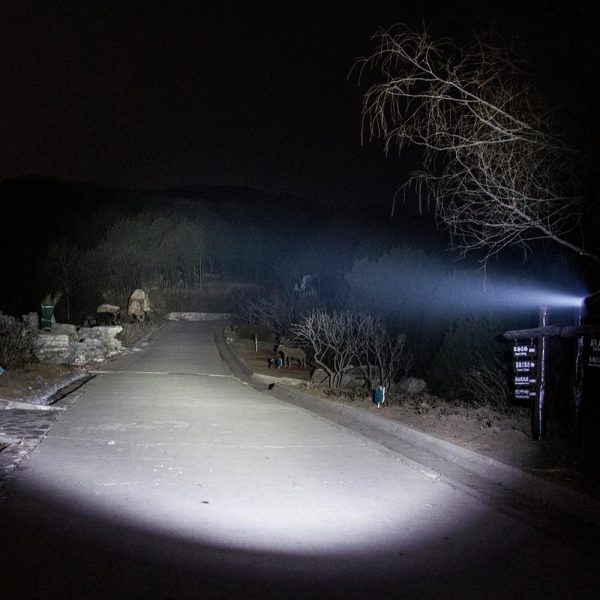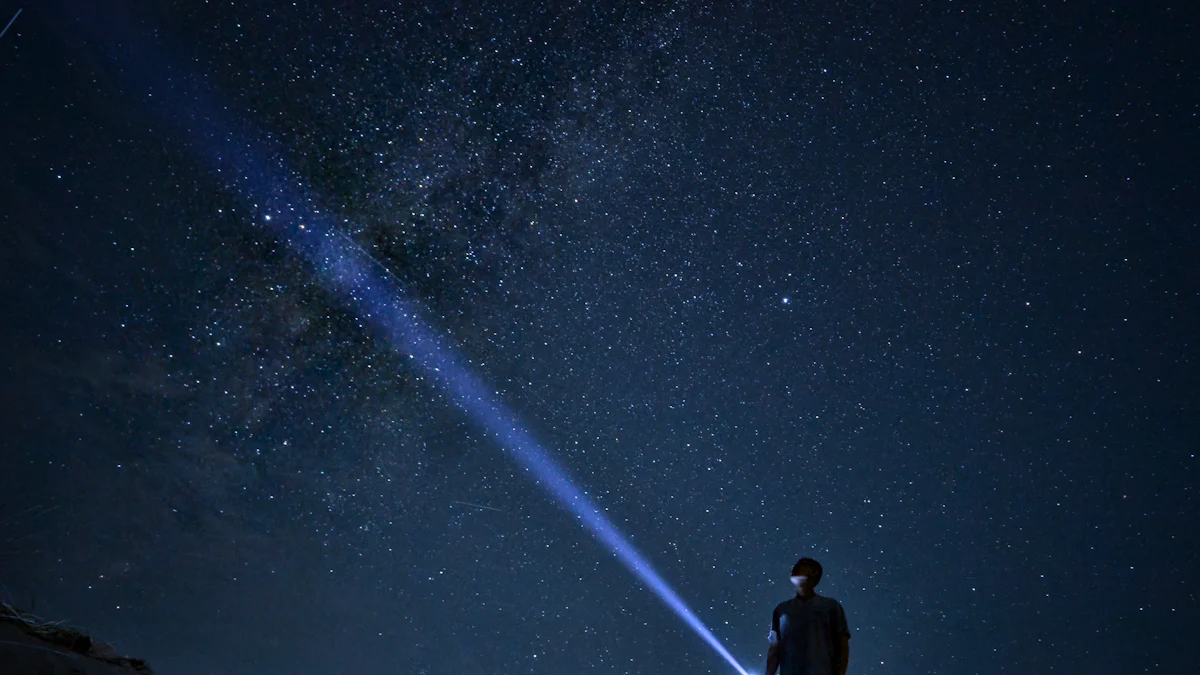The Importance of Flashlight Beam Patterns: Flood vs. Spot

Choosing the right flashlight depends on understanding beam patterns. These patterns determine how light spreads and impacts visibility. Flood beams provide wide coverage, ideal for close-range tasks. Spot beams focus light into a narrow, intense area, perfect for long distances. For activities like camping, a flood flashlight ensures optimal illumination.
Key Takeaways
Flood beams spread light widely, great for camping or indoor use.
Spot beams shine light in a small area, good for seeing far away.
Pick a flashlight based on your needs, like use and brightness.
What is a Beam Pattern?
Definition and Importance
A beam pattern refers to the way light is distributed from a flashlight. It determines how the light spreads and impacts visibility in different environments. Understanding this concept is essential when selecting a flashlight for specific tasks. The two primary types of beam patterns are flood and spot. Each serves a unique purpose, offering either wide coverage or focused intensity.
Industry standards, such as the ANSI FL1 standard, help define and measure flashlight beam patterns. This standard evaluates performance through metrics like total light output, beam intensity, and working distance. For example:
Total light output is measured in lumens using an integrating sphere photometer.
Luminous intensity, measured in candelas, focuses on the brightest spot in the beam.
These measurements ensure consistency and reliability when comparing flashlights. By understanding beam patterns, you can make informed decisions and choose a flashlight that meets your needs.
How Beam Patterns Affect Flashlight Performance
Beam patterns significantly influence a flashlight's performance. A flood beam provides broad illumination, making it ideal for close-range activities like reading maps or lighting up a campsite. In contrast, a spot beam delivers a narrow, intense light, perfect for long-distance visibility, such as spotting objects in the dark.
The number of lumens also plays a critical role in performance. Higher lumens result in brighter light, but the beam pattern determines how that light is distributed. A flashlight with 1,000 lumens and a flood beam will light up a wide area, while the same lumens in a spot beam will focus on a distant point. Choosing the right beam pattern ensures optimal performance for your specific activity.
Spotlight vs Floodlight: Key Differences

Characteristics of a Flood Beam
A flood beam is designed to illuminate a wide area with light. Its defining feature is the beam angle, which typically exceeds 60 degrees. This wide spread ensures that the light covers a broader region, making it ideal for tasks requiring extensive visibility. However, the light intensity is lower because it disperses over a larger area. Flood beams work best for short to medium distances, such as lighting up worksites, landscapes, or outdoor spaces. If you need to illuminate a campsite or inspect a large room, a flood beam flashlight is your go-to choice.
Characteristics of a Spot Beam
A spot beam focuses light into a narrow, concentrated pattern. Its beam angle is usually less than 45 degrees, allowing it to project light directly forward with high intensity. This makes it perfect for long-range applications where precision is key. Spot beams excel at illuminating specific objects or areas in the distance. For example:
They are ideal for search-and-rescue operations.
They help you spot distant landmarks during nighttime hikes.
They provide focused lighting for hunting or tactical scenarios.
If your activity requires long-distance visibility, a spot beam flashlight will deliver the performance you need.
Comparing Coverage and Intensity
When comparing spotlight vs floodlight, the primary difference lies in coverage and intensity. Flood beams cover a larger area with a wide spread of light, making them suitable for shorter distances. In contrast, spot beams concentrate their light into a narrow beam, offering higher intensity for long-range tasks. Choosing between the two depends on your specific needs. If you prioritize broad coverage, a flood beam is the better option. For focused, long-distance lighting, a spot beam is the superior choice.
Applications of Flood and Spot Beams

Best Uses for a Flood Flashlight
A flood flashlight excels in situations requiring broad illumination. Its wide beam angle makes it perfect for tasks where you need to light up a large area. For example, it is ideal for camping trips, where you can use it to illuminate your entire campsite. It also works well for indoor activities like inspecting a room or performing repairs in dimly lit spaces.
Floodlights are particularly useful in work environments. Construction sites often rely on floodlights to ensure workers can see clearly across a wide area. Similarly, photographers and videographers use floodlights to create even lighting for their shots. If you need consistent and widespread light, a flood flashlight is your best choice.
Ideal Scenarios for Spot Beams
Spot beams are designed for precision and long-distance visibility. They are commonly used in search-and-rescue operations to illuminate specific areas or objects from afar. Off-road drivers also rely on spot beams to identify obstacles in the distance, ensuring safe navigation in challenging terrains.
Other scenarios where spot beams shine include nighttime hiking and hunting. Their narrow, high-intensity beam allows you to focus on distant landmarks or targets. Whether you are exploring the wilderness or engaging in tactical activities, a spot beam flashlight provides the focused light you need.
Spot beams are used in:
Search-and-rescue operations
Off-road driving
Long-distance visibility tasks
Choosing Based on Specific Activities
Some activities benefit from a combination of flood and spot beams. Off-road driving, for instance, requires both wide coverage and focused intensity to navigate safely. Outdoor enthusiasts often use flashlights with adjustable beam patterns for versatility. Commercial applications, such as security and maintenance, also demand a mix of floodlight and spot beam capabilities.
When choosing a flashlight, consider your specific needs. If you prioritize wide coverage, opt for a flood flashlight. For tasks requiring precision and long-range visibility, a spot beam is the better choice. For maximum flexibility, look for flashlights that allow you to switch between flood and spot modes.
Pros and Cons of Each Beam Pattern
Advantages of Flood Beams
Flood lights provide excellent coverage, making them ideal for illuminating large areas. Their wide light pattern ensures you can see everything around you, which is perfect for tasks like camping or working in dimly lit spaces. These beams distribute light output evenly, reducing shadows and creating a softer glow. This makes flood lights particularly useful for close-range activities where clarity across a broad area is essential.
Flood beams also excel in work environments. They allow you to focus on multiple objects at once without needing to adjust the flashlight. This versatility makes them a reliable choice for construction sites, photography, and general outdoor use.
Advantages of Spot Beams
Spot beams deliver high intensity and precision. Their narrow light pattern focuses light output into a concentrated area, allowing you to see objects at a distance. This makes spotlights invaluable for activities like search-and-rescue operations, hunting, or nighttime hiking.
Spotlights are designed for long-range visibility. You can use them to identify distant landmarks or navigate challenging terrains. Their focused beam ensures minimal light dispersion, which helps conserve battery life while maintaining brightness.
Limitations of Both Beam Types
Flood lights and spot beams each have limitations. Flood lights lack the high intensity needed for long-distance tasks. Their wide coverage sacrifices brightness, making them unsuitable for precision work. On the other hand, spotlights struggle with illuminating large areas. Their narrow beam limits peripheral visibility, which can be a disadvantage in close-range scenarios.
Choosing the right beam depends on your specific needs. While flood lights excel in broad illumination, spot beams are better for focused, long-range tasks.
How to Choose the Right Beam Pattern
Assessing Your Needs
Choosing the right flashlight starts with understanding your specific requirements. Ask yourself how and where you plan to use it. For outdoor activities like camping or hiking, you may need a flashlight with wide light coverage to illuminate your surroundings effectively. On the other hand, tasks such as night driving or search-and-rescue operations demand a focused beam for long-distance visibility.
The table below outlines key factors to consider when assessing your needs:
Factor | Description |
|---|---|
Intended Use | Determine the primary purpose of the flashlight, such as outdoor exploration, worksite use, or emergency preparedness. |
Battery Type | Decide between disposable or rechargeable batteries based on your usage frequency and budget. |
Lumens and Candela | Lumens measure total brightness, while candela indicates peak intensity. Both influence the beam's effectiveness. |
Bulb Type | The bulb type (LED, xenon, halogen) affects performance and longevity, impacting usability and light coverage. |
Factors to Consider (e.g., Distance, Coverage, Brightness)
Distance, light coverage, and brightness are critical when selecting a flashlight. For example, a flashlight with 1–250 lumens works well for everyday tasks, while 400–1000 lumens are better suited for outdoor activities like hiking or caving. If you need a flashlight for extreme conditions or night driving, consider models with 3000–70000 lumens for enhanced visibility.
The table below highlights how these factors influence your choice:
Lumens | Distance | Best For |
|---|---|---|
1–250 | Up to 80 m | Everyday use, leisure activities in dim conditions |
160–400 | Up to 100 m | Camping, hiking, backpacking |
400–1000 | Up to 200 m | Hiking, caving, campervan engine repair |
1000–30000 | Up to 350 m | Fishing, hunting, rock climbing |
3000–70000 | Up to 500 m | Extreme weather, mountaineering, emergency rescue |
7000–15000 | Up to 700 m | Lighting large areas, emergency rescue, mountaineering in harsh conditions |
Tips for Selecting the Best Flashlight
Follow these expert tips to find the perfect flashlight for your needs:
Match lumens to your activity. For camping or hiking, 200–600 lumens provide sufficient brightness. For search-and-rescue or hunting, opt for 600–1000+ lumens.
Choose the right beam type. Flood beams offer wide light coverage, while spot beams focus on long-distance visibility. Adjustable beams provide versatility for various tasks.
Consider battery type. Rechargeable batteries are cost-effective for frequent use, while disposable ones are convenient for occasional use.
Prioritize durability. Select a flashlight that can withstand tough outdoor conditions and is waterproof if necessary.
By evaluating these factors, you can confidently select a flashlight that meets your specific needs, whether for outdoor adventures or night driving.
Understanding flashlight beam patterns helps you make informed decisions. Flood beams provide wide coverage, while spot beams offer focused intensity.
To choose the right flashlight, consider:
Your specific applications and tasks.
Matching the beam pattern to your needs.
Tools like Streamlight’s online beam demonstration for visualization.
Feature | Flood Beam | Spot Beam |
|---|---|---|
Beam Angle | Typically more than 60 degrees | Often less than 45 degrees |
Light Spread | Wide spread, illuminates a larger area | Narrow focus, illuminates a specific area |
Ideal Use Cases | Landscape lighting, construction sites | Long-range lighting, spotting obstacles |
Distance | Short to medium distance | Greater distances with concentrated intensity |
Evaluate your needs carefully to select the optimal flashlight for your activities.
FAQ
What is the best flashlight for outdoor lighting?
For outdoor lighting, choose a flashlight with a flood beam. It provides broad coverage, making it ideal for camping, hiking, or illuminating large areas.
Can LED floodlights replace traditional flashlights?
Yes, LED floodlights offer better energy efficiency and durability. They excel in lighting applications requiring wide, even illumination, such as workspaces or outdoor activities.
When should you use a spotlight application?
Use a spotlight application for tasks requiring focused, long-distance visibility. It works best for search-and-rescue missions, hunting, or identifying distant objects in the dark.
See Also
Comparing Police Flashlights And Standard Flashlights: A Guide
Understanding The Variations Between Diving And Regular Flashlights
Selecting Between Zoomable Flashlights And Reflector Caps
